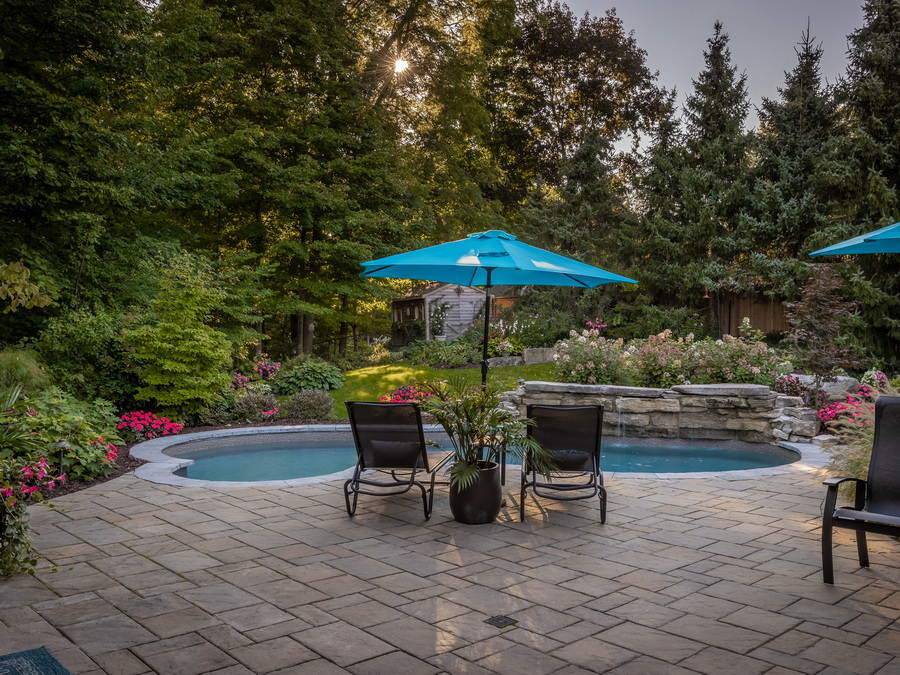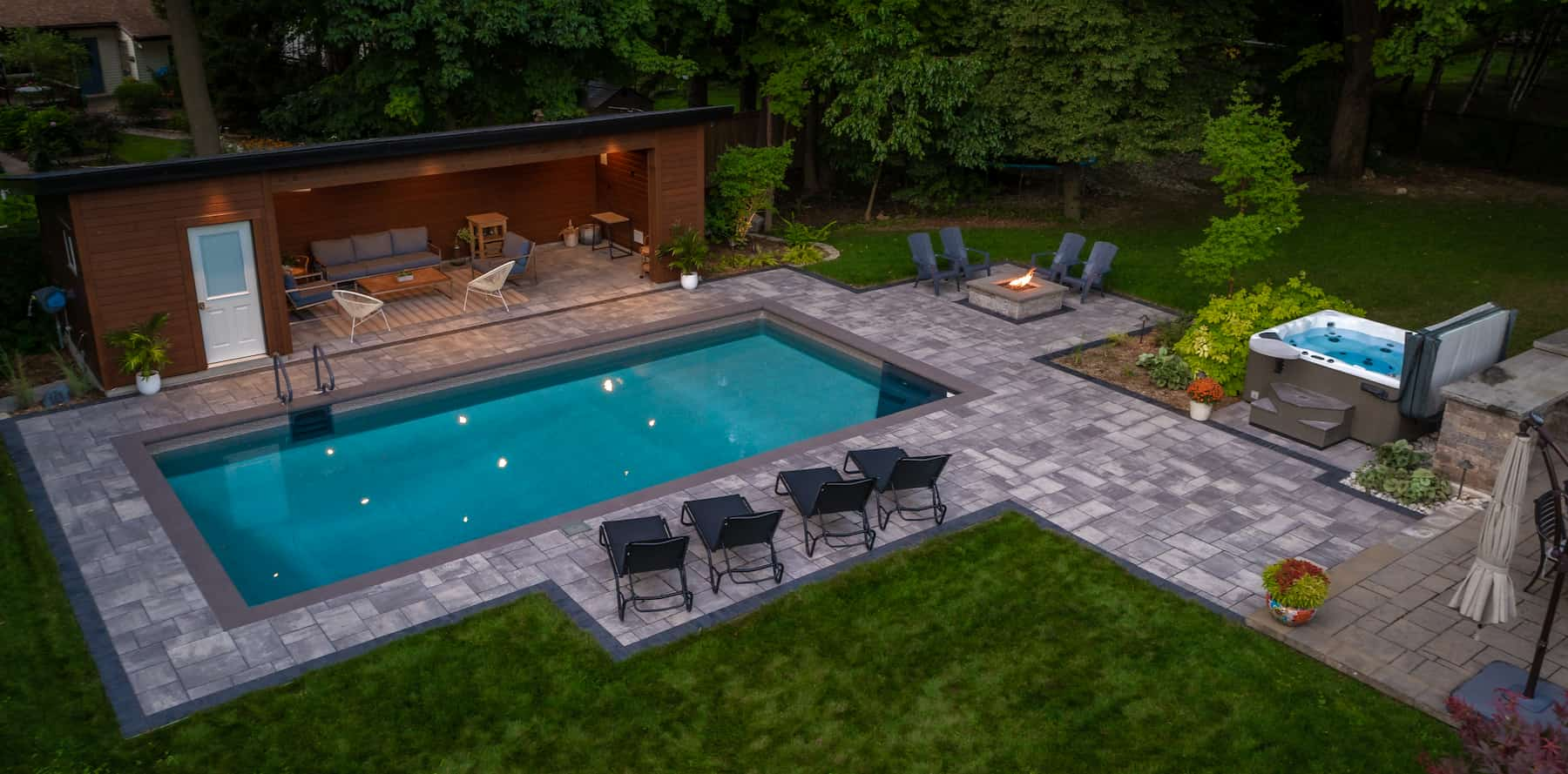
Owning a backyard pool in London, Ontario, is a true joy during the hot summer months. They’re a center for family fun and a refreshing escape. However, with this privilege comes the responsibility of keeping it in top shape. Without regular pool maintenance, you risk shortening your pool’s lifespan, compromising swimming safety, and diminishing its beauty and value. A neglected pool can lead to murky water, structural issues, and costly problems down the road, taking away your peace of mind as a homeowner.
This blog will guide you through the key aspects of effective pool maintenance, from routine upkeep and seasonal care to recognizing when renovations are needed and how thoughtful landscaping can simplify the process. By staying on top of pool care, you can ensure crystal-clear water and a longer-lasting structure and maximize the enjoyment of your outdoor oasis.
Why Regular Pool Maintenance Matters

Regular upkeep delivers many benefits for pool owners. Safety and water quality are greatly improved – routine care prevents harmful bacteria or algae buildup, keeping swimmers healthy and comfortable. Balanced chemicals and clean water mean no red eyes, skin irritations, or unpleasant odours.
At the same time, consistent maintenance prolongs the life of your pool and equipment. Keeping pumps, filters, and heaters clean and serviced reduces strain, avoiding the accelerated wear and tear that neglect can cause. In the long run, taking care of your pool’s water and mechanics ensures everything runs efficiently and lasts longer.
Another advantage is cost savings through prevention. It’s much cheaper to address minor issues during regular maintenance than to fix significant damage later.
For example, catching a small leak or crack early is far less expensive than repairing a large structural problem down the road. If maintenance is ignored, slight imbalances or faults can escalate into serious issues requiring extensive (and costly) repairs. Lastly, a well-maintained pool preserves your home’s aesthetic appeal and property value.
Crystal-clear water and well-kept pool surfaces make your backyard inviting, whereas a green, dirty pool or broken features can become an eyesore. A pool that’s in excellent condition is seen as an asset rather than a headache by future buyers, so protecting your pool with regular care also protects your investment.
Essential Pool Maintenance Tasks

To keep your pool in prime condition, make sure these core tasks are on your checklist:
- Regular Cleaning: Skim leaves and debris off the surface daily or as needed. Vacuum the pool floor and brush the walls and waterline weekly to prevent algae and dirt buildup.
- Water Chemistry Balancing: Test your pool water at least once a week and after heavy rain or usage. Maintain proper pH (around 7.2–7.8) and chlorine levels (1–3 ppm) to keep the water sanitary and protect pool surfaces from corrosion or scale.
- Equipment Maintenance: Check that your pump, filter, heater, and other equipment are working correctly. Empty the skimmer and pump baskets frequently to ensure strong circulation. Clean or backwash your filter when the pressure rises beyond normal so it can effectively trap debris. Also, run your pump daily for enough hours to filter all the water (about 8 hours a day for many pools).
- Seasonal Care: In the Fall, winterize your pool properly to guard against freezing damage and algae over the winter. This includes lowering the water level, blowing out lines, adding winter chemicals, and covering the pool securely. In spring, open the pool by removing the cover, refilling and balancing the water, and restarting the equipment. During hot summer spells, monitor water levels (topping up if needed due to evaporation) and adjust chemicals more frequently, since heat and heavy use can affect your pool’s balance.
Recognizing When Pool Renovation is Needed
Over time, specific issues indicate it may be time to renovate or upgrade your pool. Look out for:
- Persistent Leaks or Cracks: If you constantly need to add water or see cracks that keep returning, there could be deeper structural problems. Rather than repeatedly patching, resurfacing, or repairing the pool shell, fixing the issue for good may be necessary.
- Outdated or Failing Equipment: Older pumps, filters, or heaters that break down frequently or run inefficiently are good candidates for replacement. Upgrading modern, energy-efficient equipment during a renovation can improve performance and save operating costs.
- Worn-Out Surfaces: Noticeable wear, such as a rough plaster surface, peeling liner, chipped tiles, or stains that won’t come out, is a sign that the pool needs a refresh. Renovation can include resurfacing the interior or replacing damaged tiles and coping, instantly revitalizing your pool’s look and safety.
- Dated Design or Features: If your pool’s style feels decades old or lacks features you now want (like a shallow lounging shelf, new lighting, or improved landscaping), a renovation is the opportunity to modernize. Updating the design can make the pool more attractive and better suited to your current lifestyle and taste.
When you observe these signs, consult a professional. A pool renovation might be as simple as replacing equipment or as extensive as a complete makeover with new surfacing and added features. TLC Landscaping Design + Pools' experts can evaluate your pool’s condition and recommend the right renovation solutions. A well-planned renovation will resolve issues and enhance your pool’s functionality and beauty for the future.
Expert Tips and Common Mistakes to Avoid

While TLC doesn’t offer routine pool maintenance services, we’ve worked on countless pools and landscapes. Along the way, we’ve seen what works — and what causes problems. These tips come from years of helping clients get the most out of their pool environments. Even confident pool owners can slip up on maintenance. Here are some professional tips and common mistakes you should avoid:
- Test and Balance Water Regularly: Not checking your pool’s water chemistry often enough is a widespread mistake. If the chemistry is off, the water might look clear but still be corrosive or prone to algae. Test your water weekly and adjust chemicals to keep pH and chlorine in the proper range. Staying on top of this prevents problems and protects your pool equipment.
- Keep Up with Cleaning: Skipping basic cleaning is another pitfall. Remember to skim debris daily or every other day, and brush the pool walls and floor weekly so algae and dirt can’t accumulate. Consistent skimming and brushing (along with a working pool vacuum) will save you from tougher clean-ups later. It’s much easier to prevent grime than to scrub it off after it’s grown.
- Run the Filter Sufficiently: Many pool owners don’t run their pump and filter long enough daily. Turning off the filtration too early can lead to cloudy, stagnant water. Make sure to run the pump for around 8 hours daily (or more, depending on pool size) so all water gets filtered. Also, clean or backwash your filter periodically to keep it working efficiently. Good circulation and a clean filter go a long way toward a trouble-free pool.
- Prioritize Seasonal Duties: Finally, don’t neglect seasonal maintenance. Failing to winterize in our Ontario climate can result in cracked pipes and heavy algae growth by spring. Always close your pool properly before winter – balance the water, add winterizing chemicals, and use a secure cover. When reopening in spring, clean and balance the water early to prevent algae blooms. A timely opening and closing routine will spare you many headaches and expenses.
Following these tips and avoiding common errors will keep your pool in great shape year-round. If you ever feel unsure about a procedure or notice something unusual, it’s wise to call in professionals for help before a minor issue becomes a big problem.
Integrating Landscaping with Pool Maintenance
%20(1)-1.jpg?width=800&height=600&name=DJI_0009%20(1)%20(1)-1.jpg)
Your pool’s surroundings can ease or add to your maintenance burden. To keep things low-maintenance, be strategic with your landscaping choices. Opt for plants that won’t constantly shed leaves or debris into the water.
Evergreens, low-litter shrubs (like cedars or boxwood), or ornamental grasses are great poolside options – they provide greenery and privacy without clogging your skimmer daily. In contrast, planting messy deciduous trees right next to the pool (think maples or oaks) will lead to many leaves in the water each fall.
If you want shade trees, consider planting them further from the pool or choose varieties that produce less debris. It’s also wise to be mindful of root systems: avoid large trees with invasive roots near the pool, since roots can damage the pool structure or plumbing over time.
In terms of hardscaping, a well-designed pool area uses patios, pavers, or stone borders to keep dirt and mulch from washing into the pool. A concrete ribbon or a bed of decorative rock around the pool edge can act as a buffer that catches debris before it blows into the water.
Likewise, ensure lawn areas slope away from the pool to prevent runoff from entering the water after rain. By combining imaginative planting with functional hardscaping, you can have gorgeous pool landscaping that enhances your yard and reduces daily maintenance. Thoughtful design means less time cleaning and more time enjoying your outdoor space.
Pool Landscaping and Maintenance with You in Mind
%20(1)-1.jpg?width=900&height=600&name=TLC%20construction%20backyard%200122%20(1)%20(1)-1.jpg)
Taking a proactive approach to pool care is the key to enjoying your backyard oasis for years. While regular maintenance is essential, the design of your pool environment also plays a big role in how much upkeep is required. At TLC Landscaping Design + Pools, we don’t offer pool cleaning or water testing, but we specialize in designing and renovating beautiful, functional outdoor spaces that support easy pool ownership. If your backyard needs an upgrade or your pool area no longer suits your lifestyle, our team is here to help. Request a consultation today to explore how thoughtful design can improve your poolside space.


